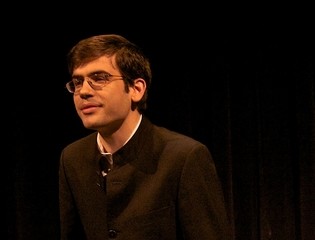|
Back
Mysteries of the Upper Chamber New York
Buttenwieser Hall
05/02/2016 -
Sir András Schiff Presents:
Claude Debussy: Préludes (Book 2): No. 7 “La Terrasse des audiences du clair de lune” – Images (Book 2)
Jean-Sélim Abdelmoula: Variations fantômes
Frédéric Chopin: Ballade No. 4 in F minor, Op. 52
Franz Schubert: Sonata in B-flat major, D. 960
Jean-Sélim Abdelmoula (Pianist) 
J.-S. Abdelmoula (© Nancy Crampton/92Y)
At rare times, artist and auditorium merge to create their own aura. That was certainly true last night for the young Swiss pianist-composer Jean-Selim Abdelmoula, who offered his music in the 92nd St. Y’s Buttenwieser Hall.
It was my first time in this intimate upstairs theater. Seating no more than 200, the hall’s intimacy was both artistic and aural. In the ceiling were beams with various vaguely Hassidic, primitively Chagall-like other-worldiness. The candelabras could have come from old Lower East Side synagogues, had it held candles instead of bulbs.
And the basically wooden walls allowed an aural intimacy as well. The Steinway didn’t resonate, the sounds didn’t bounce through the auditorium or achieve hushes and grandeur. Instead, one heard the piano on its own without augmentation, a dry yet never mechanical sound.
All of this was made for Mr. Abdelmoula, an artist who obviously demanded not only perfection from his instrument, but from the atmosphere as well. Rather than jumping onto the stage and getting down to business (à la Marc-André Hamelin), Mr. Abdelmoula sat quietly, almost piously between movements and pieces. He was not one to countenance the slightest cough or program rattle, but took his time before his fingers reached the keys.
One didn’t imagine a young Chopin seeking to glitter, but a young Liszt blessing listeners in his hall like a priest waving his thurible in an engulfed cathedral.
Speaking of which, Mr. Abdelmoula started with Debussy. Not the cathedral, but the terrace, the moon, the goldfish, the bells through the veils.
The original opener was to be Bach, but Mr. Abdelmoula seemed made for the “The Terrace for Moonlight Congregations”. My translation is murky, but so is the vaguely Hindu music. Mr. Abdelmoula never played this with a strong musical statement: he seemed more the somnambulist than the musician, caressing the keys, sometimes bringing out the theme almost as a whispering after-thought.
In the Book II Images, the pianist continued the shadowy thoughts, and here I was gratified that he was playing in Buttenwieser Hall rather than the more spacious Kaufmann Hall downstairs. Here, “The Bells Through The Leaves” left no chimes. These were the bells of a clavichord, dream-bells played in a dream-like manner.
He continued this almost hallucinatory playing for the second mystical moon-like piece. I felt no particular “moon on the temple”, but did feel the modal harmonies upon which Mr. Abdelmoula roamed. As for the “Goldfish”, nobody could ever accept his playing as a piscatorial simulation. Most of our pet goldfish are tranquil creatures. Mr. Abdelmoula saw the Debussy images as churning, dashing, turning fishy somersaults (he timed the tremolos perfectly: no extra rubati for strict tempos that formed their own world), no superfluous pedaling. The cadenza showed Mr. Abdulmoula not so much the Swiss composer as a a student of Guildhall. He sure knows his digital techique.
His own work, Variations Fantômes was more phantasmagorical than “variation” The amorphous theme rose out of the depths like a tune by Scriabin continuing (and I suppose varying) into about six minutes of atmosphere, which fit in perfectly after the Debussy.
This being a New York premiere, the audience was as hushed as the final measures, so he segued immediately into the Chopin Fourth Ballade. The opening was equally subdued, and one was almost taken aback as he launched into faster sections of the work. In fact, it was the first time in the evening that he touched on the Early Romantic, and, while it was played well, that patina of shadows and mirrors had cracked, bringing us into reality.
Like so many pianists in New York, Mr. Abdelmoula ended with Schubert’s B Flat Sonata, and the first two movements were played without fault. Mainly, perhaps, because these were mystical, almost subconscious utterances.
Jeremy Denk ended his recital last week with the same piece, but for some reason didn’t repeat the exposition of the first movement. That, though, was not a simple repeat: Schubert had added some abrupt measures that added to the dark cloak of the music. Mr. Abdelmoula did play that repeat, and the first two movements were (with the exception of some audience morons applauding) quite beautiful.
After an evening of such poetry, the final two sections were unavoidably disappointing. Schubert’s dark fantasies were transmuted into pleasantly mundane bit of Mendelssohn. Played well enough, but not enjoying the shadowy undertones at which only perhaps a rare more seasoned pianist can hint.
One only wishes that Schubert had finished with the second movement Andante sostenuto, and let this be his “Unfinished” sonata. Still, Mr. Abdelmoula had held his audience before this, not with bravo playing but through nuance, poetry and intimation.
Harry Rolnick
|